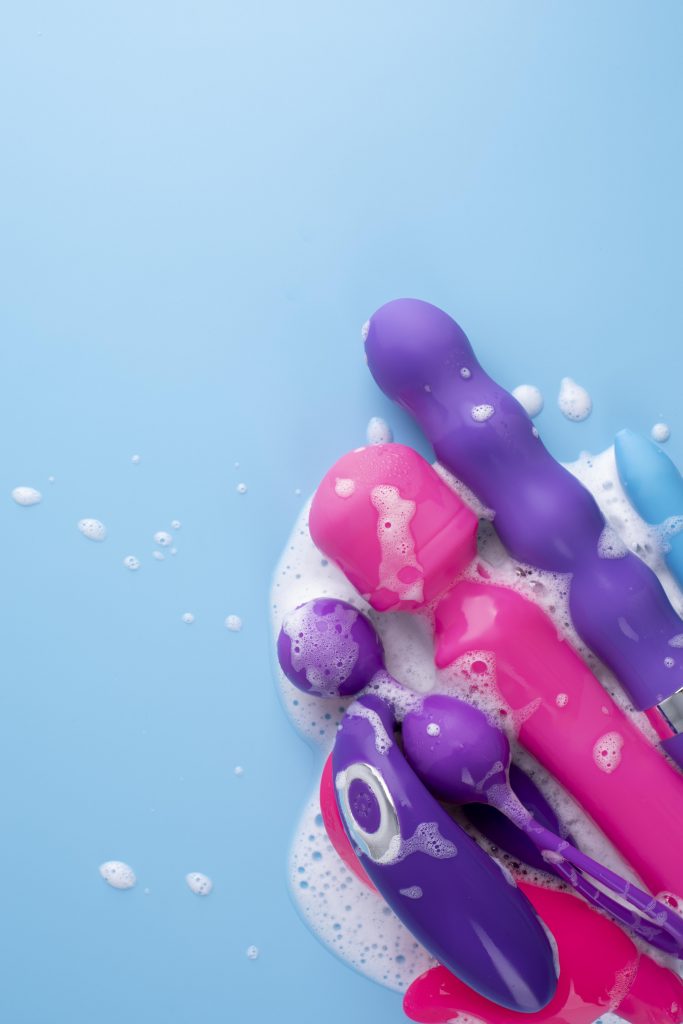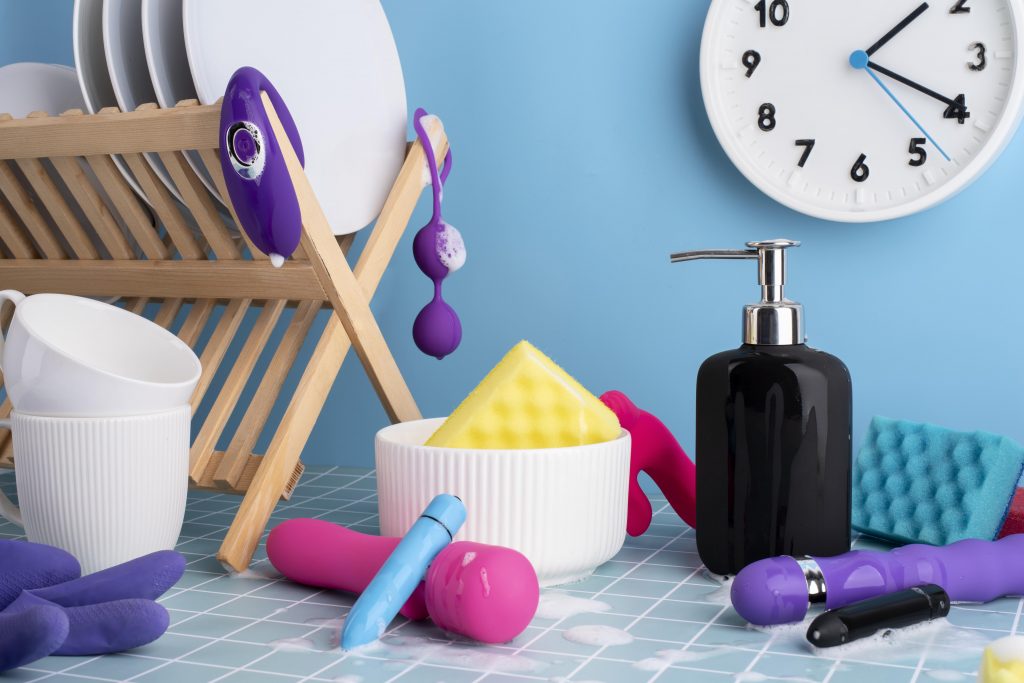Sex toys like vibrators, dildos, and anal toys come in direct contact with bodily fluids, so it’s important to know how to clean them properly. Cleaning your sex toys doesn’t have to be complicated, but the consequences of neglecting to do so can be.
Using unclean sex toys can potentially introduce unwanted bacteria or other pathogens—like fungi—into the vulvar-vaginal environment can lead to the overgrowth of bacteria known as bacterial vaginosis or cause a urinary tract infection. It is especially important to thoroughly clean toys that are used by multiple partners. Almost every type of sex toy can be surface-cleaned, using liquid soap and water, and then air-dried. But we will also identify situations where it’s better to thoroughly disinfect your toys.
Although here we provide general guidelines for cleaning different types of sex toys, it is always a good idea to also refer to your toy’s manual, if possible, to learn the best way to clean it. Our cleaning advice is intended for nonporous toys that are used on the genitals and that are made of materials such as 100% silicone, metal, borosilicate glass, or hard plastic, like ABS or TPC. It’s difficult to thoroughly clean porous toys, including jelly rubber, “silicone blend,” PVC, leather, and certain types of stones. Porous toys can harbour bacteria, so experts do not recommend using them.
Note, though, that not all toys marketed as silicone are 100% silicone, particularly toys that have a “soft skin”–type texture. You can try a flame test to confirm that your toy is 100% silicone: You should be able to hold a lighter to the toy for a quick spot check without the toy’s surface melting. We recommend doing this flame test only with nonmechanized toys like dildos.

Basic Surface Cleaning
Virtually every kind of sex toy can be cleaned with a thorough scrub. This technique does not disinfect or sterilize the toy. But in most cases, surface cleaning is sufficient if you are the only person who will be using the toy. Before starting, determine your toy’s water safety rating. If the toy is nonmechanized (such as a solid silicone dildo), or mechanized but rated as being splashproof or waterproof, it’s safe to rinse the toy with water in the sink.
If a toy is splashproof, that means it’s safe to get its surface wet. If a toy is waterproof, then it’s safe to totally submerge it up to a certain depth. A toy’s box or manual will generally indicate whether the toy is waterproof or splashproof. If the toy is not water-safe, it should only be wiped down with a damp paper towel or washcloth—not rinsed or submerged in water. If the toy is battery-operated, remove the batteries prior to cleaning.
Rinse the toy with water, or wipe the surface of the toy with a damp paper towel or washcloth to remove any surface debris. Then apply liquid soap directly to the toy and scrub, if you’re washing it in the sink, or wipe it again with a damp cloth and some liquid soap.
If the toy has grooves or crevices that trap gunk, use a soft toothbrush you’ve dedicated to this purpose to remove any debris. Then rinse or wipe the toy until it is completely clean, using plain water.
Place the clean toy on a clean towel and allow it to air-dry. Air-drying is best for most toys to avoid lint getting stuck to the toy and to give it time for any nooks and crannies to fully dry. We also recommend allowing battery-operated toys to dry with the battery case open.
A note on sex-toy cleaning sprays and wipes: There are multiple products marketed specifically for cleaning sex toys, but in most cases, plain soap and water are equally good.
Disinfecting or Sanitizing
Sometimes a simple cleaning is not enough. These are some situations where it’s advisable to disinfect a toy:
- The toy will be shared by people who are not fluid-bonded. (You can also cover the toy with a condom when sharing it.)
- The toy has come into contact with genitals during an active yeast, bacterial, or sexually transmitted infection, and it might be harbouring the associated pathogens.
- You want to use the same toy both anally and vaginally. Experts advise using condoms in this case.
- You want to remove odour from an anal toy. Smell retention can sometimes be an issue with silicone toys in particular.
These techniques will kill most pathogens. Meanwhile, the dishwasher can be effective for killing bacteria, but not viruses or fungi. These steps can also be useful for removing odours from silicone toys.
Boiling
You can disinfect 100% silicone, stainless steel, and borosilicate glass toys by first surface-cleaning them, and then submerging them in a pot of boiling water for three minutes. Remove the boiled toy from the water with tongs, and allow it to air-dry on a clean towel. Do not rinse with cold water immediately after boiling because the extreme temperature change may stress the material.

Dishwashing
You can also deep-clean quite a few nonmechanized 100% silicone, stainless steel, and borosilicate glass toys at once by placing them on the top rack of the dishwasher after surface-cleaning them. Then run the dishwasher on the sanitize cycle without soap (which is too harsh to be used with sex toys). This method is not recommended if you share the dishwasher with people other than sexual partners.
A federal standard requires that the sanitizing cycle on residential dishwashers reaches 150 degrees Fahrenheit and is able to kill 99.999 percent of bacteria. This is hot enough to wipe out most bacteria and some other microbes of concern, but not necessarily enough to kill especially heat-tolerant viruses and fungi. When in doubt, boiling or bleaching are better bets than using the dishwasher.
Bleaching
Toys can be disinfected using a bleach solution after surface cleaning. Experts recommend making a bleach solution using the ratio of five tablespoons (⅓ cup) of household bleach per gallon of water. Either spray the toy with the bleach solution and let sit for 10 minutes or submerge the toy in the bleach solution for 10 minutes. This advice is based on CDC recommendations for disinfection. Only toys rated as 100% waterproof (not splashproof) are safe to submerge in a bleach solution. Following the bleach treatment, thoroughly wash the toy with soap and water once more.
How to Store Sex Toys to Keep Them Clean
Once you’ve cleaned your toys, it’s important to store them properly so they stay clean until their next use. Many sex toys come with a fabric pouch, case, or box they can be stored in when not in use, but any sealable pouch or case is fine for a nonporous toy. This will keep your toy dust- and lint-free.
Though nonmotorized toys made from solid silicone, borosilicate glass, and stainless steel tend to be extremely durable and long-lasting, a toy should be disposed of if it has any “visible cracks in plastic, acrylic or glass,” according to clinical experts, since these defects can make the toy both dangerous to use and difficult to clean. The same goes for rips or tears in silicone toys.


